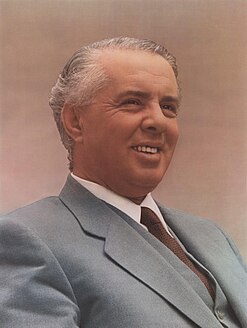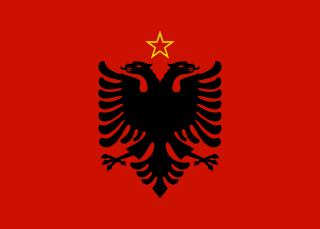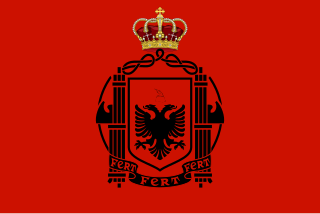
Enver Halil Hoxha was an Albanian communist politician. He was First Secretary of the Party of Labour of Albania from 1941 until his death in 1985. He was also a member of the Politburo of the Party of Labour of Albania, chairman of the Democratic Front of Albania, and commander-in-chief of the armed forces from 1944 until his death. He was the 22nd Prime Minister of Albania from 1944 to 1954 and at various times was both foreign minister and defence minister of the People's Socialist Republic of Albania.
The history of Albania forms a part of the history of Europe. During classical antiquity, Albania was home to several Illyrian tribes such as the Ardiaei, Albanoi, Amantini, Enchele, Taulantii and many others, but also Thracian and Greek tribes, as well as several Greek colonies established on the Illyrian coast. In the 3rd century BC, the area was annexed by Rome and became part of the Roman provinces of Dalmatia, Macedonia and Moesia Superior. Afterwards, the territory remained under Roman and Byzantine control until the Slavic migrations of the 7th century. It was integrated into the Bulgarian Empire in the 9th century.

Tirana is the capital and largest city of Albania. It is located in the centre of the country, enclosed by mountains and hills with Dajti rising to the east and a slight valley to the northwest overlooking the Adriatic Sea in the distance. Due to its location at the Plain of Tirana and the close proximity to the Mediterranean Sea, the city is particularly influenced by a Mediterranean seasonal climate. It is among the wettest and sunniest cities in Europe, with 2,544 hours of sun per year.

Zog I, born Ahmed Muhtar bey Zogolli, taking the name Ahmet Zogu in 1922, was the leader of Albania from 1922 to 1939. At age 27, he first served as Albania's youngest ever prime minister (1922–1924), then as president (1925–1928), and finally as king (1928–1939).

The University of Tirana is a public university located at the central borough of Tirana 10 in Tirana, Albania. It was established as the State University of Tirana in 1957 through merging of five existing institutes of higher education.

In Albania, World War II began with its invasion by Italy in April 1939. Fascist Italy set up Albania as its protectorate or puppet state. The resistance was largely carried out by Communist groups against the Italian and then German occupation in Albania. At first independent, the Communist groups united in the beginning of 1942, which ultimately led to the successful liberation of the country in 1944.

Mehmet Shehu was an Albanian communist politician who served as the 23rd Prime Minister of Albania from 1954 to 1980. As an acknowledged military tactician, without whose leadership the communist partisans may well have failed in their battle to win Albania for the Marxist-Leninist cause, Shehu exhibited an ideological understanding and work ethic that singled him out for rapid promotion in the communist party. Mehmet Shehu shared power with Enver Hoxha from the end of the Second World War. According to official Albanian government sources, he committed suicide on December 18, 1981, after which the entire Shehu clan were arrested and imprisoned while Mehmet Shehu himself was denounced as "one of the most dangerous traitors and enemies of his country". Persistent rumors remain, however, that Shehu was actually murdered on orders from Hoxha.

The Party of Labour of Albania, sometimes referred to as the Albanian Workers' Party (AWP), was the ruling and sole legal party of Albania during the communist period (1945–1991). It was founded on 8 November 1941 as the Communist Party of Albania but changed its name in 1948. The party was dissolved on 13 June 1991 and succeeded by the Socialist Party of Albania. For most of its existence, the party was dominated by its First Secretary, Enver Hoxha, who was also the de facto leader of Albania.
The Sino-Albanian split was the gradual worsening of relations between the People's Socialist Republic of Albania and the People's Republic of China in the period 1972–1978. Both countries had supported each other in the Soviet–Albanian and Sino-Soviet splits, together declaring the necessity of defending Marxism–Leninism against what they regarded as Soviet revisionism within the international communist movement. By the early 1970s, however, Albanian disagreements with certain aspects of Chinese policy deepened as the visit of Nixon to China along with the Chinese announcement of the "Three Worlds Theory" produced strong apprehension in Albania's leadership under Enver Hoxha. Hoxha saw in these events an emerging Chinese alliance with American imperialism and abandonment of proletarian internationalism. In 1978, China broke off its trade relations with Albania, signalling an end to the informal alliance which existed between the two states.

The People's Socialist Republic of Albania was the Marxist-Leninist one party state that existed in Albania from 1976 to 1992. From 1944 to 1946, the state of Albania was known as the Democratic Government of Albania and from 1946 to 1976 it was known as the People's Republic of Albania.

The Albanian Kingdom was the official name of Albania between 1928 and 1939. Albania was declared a monarchy by the Constituent Assembly, and President Ahmet Bej Zogu was declared King Zog I. The kingdom was supported by the fascist regime in Italy, and the two countries maintained close relations until Italy's sudden invasion of the country in 1939. Zog fled into exile and never saw his country again. The Communist Party of Labor of Albania gained control of the country toward the end of World War II, established a communist government, and formally deposed Zog.

The Albanian Republic was the official name of Albania as enshrined in the Constitution of 1925. Albania became a de facto protectorate of the Kingdom of Italy after the signing of the Treaties of Tirana of 1926 and 1927. Albania was declared a constitutional monarchy in 1928. Upon its inception, Italy demanded to be allies with the republic. This was done largely to increase Italy's influence in the Balkans, and to aid Italian and Albanian security in their territorial feuds with the Second Hellenic Republic and the Kingdom of Yugoslavia.

The Italian protectorate of Albania, also known as the Kingdom of Albania or Greater Albania, existed as a protectorate of the Kingdom of Italy. It was practically a union between Italy and Albania, officially led by Italy's King Victor Emmanuel III and its government: Albania was led by Italian governors, after being militarily occupied by Italy, from 1939 until 1943. During this time, Albania ceased to exist as an independent country and became an autonomous part of the Italian Empire. Officials intended to make Albania part of a Greater Italy by assimilating Albanians as Italians and colonizing Albania with Italian settlers from the Italian Peninsula to transform it gradually into an Italian land.

The Italian invasion of Albania was a brief military campaign by the Kingdom of Italy against the Albanian Kingdom. The conflict was a result of the imperialist policies of Italian dictator Benito Mussolini. Albania was rapidly overrun, its ruler King Zog I forced into exile in neighbouring Greece, and the country made part of the Italian Empire as a protectorate in personal union with the Italian Crown.

Relations between Albania and the United States of America were first established in 1912, following Albania's independence from the Ottoman Empire, ending in 1939 due to German and Italian occupation in the Second World War, and re-established in 1991 after the fall of communism in Albania and the dissolution of the Soviet Union.

The establishment of diplomatic relations between Albania and the Soviet Union happened on April 7, 1924. Both countries were also allies in the Warsaw Pact. Albania has an embassy in Moscow. Russia has an embassy in Tirana.

The Italian colonists in Albania were Italians who, between the two world wars, moved to Albania to colonize the Balkan country for the Kingdom of Italy. Many of them promoted the union of Albania to Italy

The National Liberation Movement, also translated as National Liberation Front, was an Albanian communist resistance organization that fought in World War II. It was created on 16 September 1942, in a conference held in Pezë, a village near Tirana, and was led by Enver Hoxha. Apart from the figures which had the majority in the General Council it also included known nationalists like Myslim Peza. In May 1944, the Albanian National Liberation Front was transformed into the government of Albania and its leaders became government members, and in August 1945, it was replaced by the Democratic Front.

Spiro Koleka was an important Albanian statesman, communist politician and a high-ranking military officer during World War II. He was a civil engineer by profession. Spiro Koleka served as a parliament member in all legislatures from 1944 until 1990. Koleka was a member of the Politburo of the Party of Labor of Albania during the years 1948 to 1981. As part of his political career he also served as Chairman of the State Planning Commission, Minister of Industry and Construction of Albania, as well as Vice Prime Minister.

The Albanian–Soviet split was the gradual deterioration of relations between the Union of Soviet Socialist Republics (USSR) and the People's Republic of Albania, which occurred in the 1955–1961 period as a result of Soviet leader Nikita Khrushchev's rapprochement with Yugoslavia along with his "Secret Speech" and subsequent de-Stalinization, including efforts to extend these policies into Albania as was occurring in other Eastern Bloc states at the time.






















